Having Fun
The Traditional Way
By Aasha M. Amin, Abak Hussain,
Lavina A. Ahmed and Shamim Ahsan

For boys, the 'gulail' or 'gulti' was an important part of growing up.
Of all the stages in our lives it is our childhood that we remember most fondly. It is the only time when we are allowed to be without much responsibility, to run wild and to play with abandon. For many of us our childhood memories are closely associated with toys that were cheaply made yet were the most prized of our possessions- a rag doll, a few clay pots and pans, a colourful kite or a rolling wooden top. Along with all this was a different kind of play culture. People lived in lively, close-knit neighbourhoods called 'paras' where the children of each house would get together in the afternoon to play chchiburi or hadudu, tilo-express or some other game that involved a lot of laughing, shouting and running around. The excitement of the competition and sheer joy of connecting with other kids, was something that made the whole ritual of playing so addictive. Although many traditional toys can still be found at village markets or melas, their presence in the cities is very rare having been quickly replaced by mechanised plastic, or metal versions. Along with them, traditional games played for hundreds of years by children of this region, are also on the verge of disappearance.These toys and games are representative of Bangali culture and psyche. They signify our people's creativity and imagination as well as the fun-loving spirit in every child. With Pahela Baishakh just around the corner SWM talks to people of various generations about the toys and games that made growing up fun.

Getting ready for a game of 'panch guti' (five pebbles).
Most traditional toys were simple and made of indigenous material such as clay or wood. Take the miniature clay pots and pans that closely resembled the ones adults used for cooking. Even cooking accessories such as clay pata puta to grind spices, spoons and ovens that could actually be used to cook were included in a girl's play paraphernalia. The best part was that while they were easily breakable they were also easily replaceable. Later, as clay utensils began to be replaced by aluminium pots and pans, play tin versions were introduced. Wood also an easily available material has been used to make many toys such as lattoo (top), bows and arrows and toy animals.

Some toys can still be found at the occasional village mela. These include the 'gudguti' (a rattle-like toy that consists of a small round drum filled with seeds with a stick attached) that is turned round and round to make a loud whining sound; the tom tom, a little drum that makes loud tapping sounds when swerved this way and that with the hand, the balloon flute- a balloon that has to be inflated first and then the air released- again to make a loud sound. The top or latim is a toy that is very much a part of the Bangalee culture. It seems to be there at every mela. Of the two types of tops there are the entirely wooden types and the ones with metal ends. The latter demands more skill as it has to be worked on the floor and has to be deftly projected using a thin piece of rope. The wooden ones come with an automatic mechanism enabling you to simply pull a string and release the top on to a wooden plate. Another curious contraption is a flat wooden drum on two clay wheels which is pulled by a string tied to two sticks. When the string is pulled, the wheels move and a tiny drumstick taps on the drum making a rattling sound. All this and much more would be found at the bazaar, during melas, or from the wandering vendor who, Pied Piper like, would have a sizable number of children of all ages, running around him to see the treasure. The arrival of the Khelna Pheriwala , in fact was always highly anticipated as he brought with him every child's fantasy. Even now once in a while you can see such a vendor walking around braving the scorching sun to bring his ware. Shocking pink, yellow, orange and red are the colours painted on these toys to attract children. While the plastic toys are quite crude looking, the wooden ones are still adorned with pretty traditional patterns.

Playing 'Hari Patil' with clay pots and pans and flower petals to make fake food.
The 'biscope' now virtually extinct, was one of the most visible characteristics of rural life, especially those of children. A young vendor, usually a boy would come to the village centre carrying a big 'magic' box, usually made of wood that had a handle on the side and two round windows and a cloth covering to stimulate a dark room. For a few annas one could look into the window, head covered by a cloth to create the appropriate darkness. Inside pictures would be shown like a slide projection when the operator cranked up the machine. The pictures would relate to a story sung in a ballad form by the operator. The stories would invariably be about kings and queens, famous folktales that came to life through the bioscope.
Playing with dolls, a universally popular activity among girls especially, has been around from the earliest times. In rural areas before the intrusion of the plastic, blond haired versions, little girls spent hours recreating a world of rag dolls or 'Kaporer putul'. Made from discarded bits of cloth and thread, the dolls with faces crudely drawn on them, could be of various sizes. A whole family of dolls were often made with the help of the adult female members of a family, perhaps an aunt, an older sister or even a mother when she had some free time. "We used to go through great pains to produce beads, ribbons and sari bits to make up the dolls' wardrobe consisting of jewellery and saris of various colours", says a veteran doll player, now a university teacher in her sixties. Sometimes beads in vibrant colours could be bought from the bazaar or else they would be taken off from necklaces. Pillows, kanthas, beds and other furniture were also part of the doll ensemble. But it was the range of activities associated with doll playing that made it so enjoyable. Girls would often get their respective dolls together and play from hours on end. 'Putul Biye' (Doll's Wedding) was always quite a grand affair with actual food being cooked and served to privileged guests usually doll keepers and their friends and a few favourite relatives. Sticking close to traditional norms, the owner of the male doll or groom could take away the female doll or bride and keep both of them. Sometimes through an amicable agreement the dolls could be returned to the respective owners thus avoiding possible heartache.

With electricity reaching the countryside, it took no time for them to switch to the all absorbing video games that have invaded the village markets.
In contrast to this sedate, gracious doll playing were the activities of boys who instinctively went for noisier, more aggressive toys. 'Teer Dhonuk' (bows and arrows) made of bamboo for mock fights, 'gulail' or gulti (catapult) to scare away birds and squirrels, or unsuspecting adults, and the butterfly sticks to race around the village.
Traditional games and toys in fact, were the favourite sources of entertainment for children and teenagers. That was prior to the cable television invasion and before the computer gained popularity in the country. Games such as kabadi or hadudu, shatchara, baraf pani, gollachut, dariabandha, birinchi, kutkut, tilo express etc used to attract the youngsters belonging to both urban and rural areas. Although these games could not be considered serious sports, the enthusiasm they would generate was remarkable indeed.

Playing with marbles can be quite an intense business.
Dangguli is basically a boy's game and is usually played in an open field. Two wooden sticks, one around 12 to 15 inches long, and another 2 to 2.5 inches long stick, are needed for this game. The bigger one is called danda ( stick ) and the smaller one is called guli. The guli is cut in the shape of a pencil which is sharpened on its both sides. So when the guli is kept on the earth with the middle part touching the ground, but both sides a little higher from the surface. Two or more players can play this game. The first player hits on one side of the guli with the danda, the guli goes upwards and after a certain height it begins to come down. Before it falls down on the earth the player has to hit it around the middle part of the guli while it is still in the air, and send it as far as possible. Each player gets three hits and the one who can hit the guli to the greatest distance in his three stipulated chances is the winner.
One of the most popular games in our country for both boys and girls is 'Hadudu', which is actually very much similar to 'Kabadi' the national sport. "It is basically the same game, in 'Hadudu' the players have to hold their breath and utter ha-du-du like some magic mantra, the only difference in kabadi is that you have to run after your opponent uttering kabadi," says Ruba, a lecturer of Economics at a private university who loved playing hadudu with her friends in her high school days. The prerequisite for this boisterous game is a field of course. All the players are divided into two teams. One player of the team goes across the middle line into the area of the other team all the while uttering 'ha-du-du' without taking any breath. His objective is to touch a player of the other team while he goes on chanting 'hadudu' and to come back to his own area without being captured by the opponent team members. If he manages to touch a player of the rival team, the latter will be declared 'out' or 'dead'. But if he is captured he is out. If all the players of one team are 'dead' or 'out, and the other team has some of its players still 'alive and kicking', the former party is said to be defeated and the latter team will score a point as the winners. Thus, the game continues.
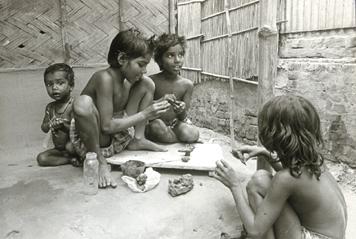
Making little pots and pans with moist clay is just as much fun as playing with them.
Nadia a 27-year-old architect says she was hooked to 'Gollachut', another action filled game. It is played between two teams of equal number of players. A team takes stand at a fixed point on one side of the field. Players of the other team position themselves at strategic points on the field facing the team that has also taken position with one 'king' at a fixed point. The players of the king's team run as fast as they can to cross the field. The players of the other team try to prevent them from reaching the crossing line. If the king's team members can cross the team without being touched by the opponent they will win the game. Nadia says, " I used to play this game with my younger sister, cousin brothers and friends 3-4 days of the week." She had once badly sprained her ankle while playing the game. Her parents were furious with her since her SSC exams were just two months away. "I was not at all perturbed about my exams I was more upset because my injury prevented me from playing for more than a month," smirks the vivacious woman who claims that she will never 'be too old' to play her favourite childhood sport 'Gollachut'. "The trouble is it would be slightly difficult to round up my old play mates and entice them to a game of 'gollachut'. Most of them have become too 'old' and boring for such adventure," she observes.
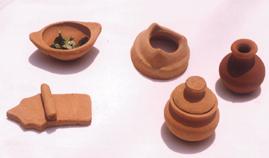
The girls of today may not be familiar with the game 'Kukut', but it used to be very popular among both school and college girls even five or six years back. The game Kutkut may seem very simple apparently but those who played it know it is not that easy to master the game. A box with eight squares is chalked out. Any number of players can take part in the game. One needs to throw the 'chara' (pebble) in the first square and push it through to the last square of the box using one foot. If the pebble touches the lines within the box, the player will be out. The player must also hold his/her breath and say 'kutkut' while pushing the pebble.
After reaching the last square the person can rest a bit and take a deep breath. Then, it's a journey back to where he/she started from in the same manner. After playing all the eight squares, a player can 'buy' a square one at a time. She/he has to stand in the semi circle in front of the box and throw the pebble in the direction of the squares. Many women remember taking part in serious 'Kutkut' matches.

In old Dhaka kite flying is still popular among children.
'Ekka Dokka' a Bangali version of 'Hop Scotch' is similar to kutkut, but the rules are much easier. For example, there is no need to utter 'kutkut' and holding one's breath.
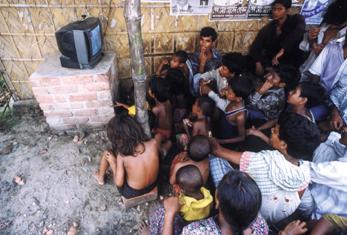
Watching T.V. has become the most popular form of entertainment even in the village, wiping out the desire to play games that were intrinsic to rural life.
Dariabandha is another game that used to have a sizeable fan following in the cities as well as the villages. In this game a field is made under certain rules equally divided with lines from each other. Players are equally divided into two teams. When a player of any team is able to cross the field from the starting point to the finishing point and vice versa, his team will win the game. Nafis an MBA working in a private computer firm was very fond of 'dariabandha' in his school/college days. "I think it was my best friend's cousin who introduced me to this wonderful game," Nafis muses. "He was a year older than us and we used to think he was very 'cool' when we were in our teens. So, naturally we liked Dariabandha since he taught the game to us." In fact, Nafis says that he continued to play the game even in his university days and had to endure a lot of teasing from his friends who considered 'Dariabandha' to be a 'soft' game for the girls!" Not that their taunting remarks bothered Nafis much. In his opinion, Dariabandha is just as 'macho' as football.
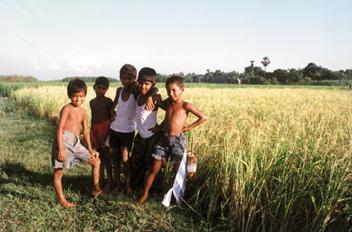
A kite flyer and his gang pose amongst the paddy fields.
Tilo-express (it can be roughly translated as hide and seek) is another interesting game. This game is usually played inside the house or in places like garage or storeroom, because the place must have a lot of places to hide. There can be players numbering anything between 3 to 6 or even more. One of them, usually chosen by lottery, closes his eyes and starts counting from say, 1 to 50/100, loudly to give others the time to hide. Once the counting is done he/she starts hunting for those who are in hiding. While searching he has to be very careful to make sure that no one can, among those who are in hiding, touch him and say Tilo. Whenever he finds one, say he has found one called Kuddus, he will have to say "Kuddus, express". In this way, he will have to find out each and everyone in hiding, but at the same time remain alert so that no one from the hiding can come out and touch him without his knowledge. After one successfully finds out everyone, it will be the turn of the player, who was found out first, to do the searching.
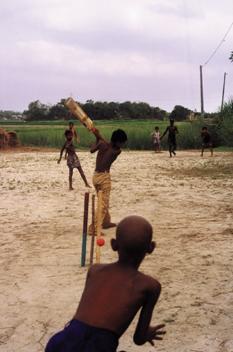
Even in the village, kids would rather play cricket than 'ha du du' or 'gollachut'.
Bagaduli is an indoor game. The Bagaduli board, shaped like the English word U turned upside down, is made of hard board. The upper portion of the board is higher than the lower part like that of a slope and the entire board is surrounded by a wall. The whole board is divided into several small areas, each of them fenced by little nails/pegs. Each of these small areas have certain points like 20, 30, 50 or100. On the right hand side of the board there is a narrow alley which starts from the lower part and goes upward. Five or six marbles are lined in that alley. One has to strike a marble with the finger or a ball pen. Once released off the alley the marble can get into any of the fenced areas or even miss all of them or get into a red marked area in which case the player is out. It all depends on the force with which one has stricken the ball. Now, after one finishes playing all his 5 marbles he will add the total and write it in a book. Then the next player will take his chance. Say, the players have decided for 5 rounds, so after all the players finish their stipulated rounds, total will be made for each of the players and the highest point getter is the winner.
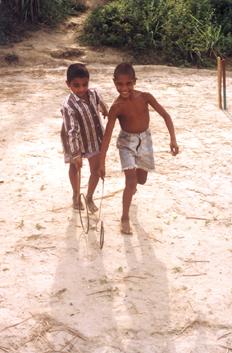
The 'fun gradient' goes up when you have a friend to come along.
If there is one game that most people, particularly those within the 20 to 30 age group like to recall with a lot of enthusiasm, it is definitely Shatchara. This game also requires two teams, a solid brick, a tennis ball and several smooth pieces of brick or dices. The tiny pieces of bricks have to be positioned one on top of the other on the big piece of brick. The team that wins the toss gets to aim the ball at the bricks. The players of the other team try to catch the ball. If the 'bowler' manages to hit the target and knock down the little brick tower, he or she has to move very quickly and attempt to pick up the pieces again. The rest of his or her team also has the same intention. Meanwhile the opponent team tries to prevent them from going near the bricks. If they can hit any of the other team members with the ball, the latter would be out of the game.
Noushin, a final year civil engineering student admits that arguments were quite common when she played outdoor games, especially when it came to Bouchi. This is also another action -packed game comprising two teams. Two circles are drawn in the field. The "bou" or the bride sits in one section and the whole purpose of the game is to rescue the bou. Her team members stay on the other circle and try to bring her back to their territory by warding off the opponent members. The opponents stand on guard and try to prevent them from getting close to the bride. The bou's team players one by one get out of their enclosure and utter 'chiburi' or 'kutkut' with the intention of capturing the players of the other party. If they manage to touch someone, he or she is out. But if they cannot hold their breaths for long, the opponent team can grab him or her. Incidentally, the 'bou' does not sit idle. He or she looks for the perfect opportunity to run from her section to where her friends are keeping an eye on the opponents who will try to stop her from achieving her mission.
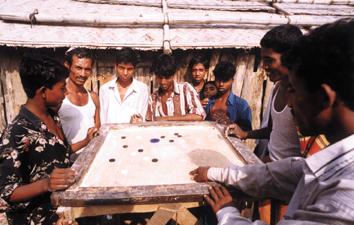
Playing the carom is quite addictive for children and adults alike.
No one really knows where the name 'Opent ti Biscope' has come from. One theory is that it is a derivation of 'Open the Biscope'. Whatever it means almost every adult today knows how it is played and most female adults have played it at least once during their childhood. Very similar to the English game of 'Oranges and Lemon', the game involves quite a number of players. The front pair form an arch by lifting and joining their arms while the rest keep going through the arch while a chant is said out loud : Openti bioscope, titan ti-scope; Sultana bebi ana, shaheb babu boithok khanai�
When the chant is over, whoever happens to be under the arch, gets caught. "There was not much challenge to the game", says Sharmin, a school teacher, " but we thoroughly enjoyed because of all the singing and just being together with friends."

Playing 'ekka doka' can be quite a balancing act.
Kite-flying was not only a popular hobby in our country but in many other countries in Asia too. In China and Japan, kite-flying festivals are grand events where ornate kites of different sizes and shapes are displayed.
The traditional Bangladeshi kite is made of two thin sticks of bamboo, a certain length of string or thread, thin paper and glue. In Bangladesh, kite-flying may not be taken to such fervent heights, but even a few years back kite-flying was an activity that most people, men or women tried at least once in their lives. As a retired Government officer Habibur Rahman recalls, "Kite-flying was my passion as a school student. Every afternoon I would go to the rooftop of a five-storey building close to my home and play with my kite." His mother used to worry a lot, since there was a risk that he might accidentally fall from the roof. "But I used to hide my kite in our store room and make up stories to fly kite every day right after lunch," he reminisces. The most interesting thing about kite-flying is the 'kite match'. In a match, several kite-fliers start flying kites. If the thread of one flier gets entangled with another both the fliers apply their own skills to try to get each other's thread cut off. When one competitor succeeds in cutting off the thread of his or her rival, he wins the match.
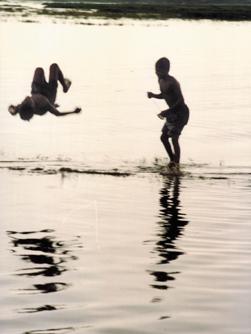
Nothing beats a good splash into the river on a hot, blistering day.
Phul Tokka is another game popular with young girls. It is played in teams. The kids divide into two teams, ideally each team consisting of four or five kids. Each team decides on a leader. The leader gives each member a code name; after a flower, like golap or shapla. The leader of a team goes up to the opposition and covers someone's eyes and calls out to a teammate by her flower name (Ay re amar golap). The person called golap walks up and taps the forehead of the blindfolded person. It is up to the blindfolded person to guess the identity of the tapper. If a player correctly guesses the identity of the tapper, he or she gets to jump forward. Players from both teams keep jumping forward until someone reaches the end line. First party to do that wins.
Chhoa Chhui is probably the simplest of all childhood games. It is basically a game where you run around and try to catch someone. The person who gets caught becomes the chor and the chor becomes the one running around trying to catch all the others. All this running is good exercise and this game is particularly good for cardiovascular fitness. A variation of this game is Kanamachhi, where the chor is blindfolded and the rest of the children constantly tease and provoke the chor by chanting the immortal chorus "Kanamachhi bho bho, jaake paash, take chho": Catch whoever you can. The blindfolded chor, madly runs around chaotically throwing his hands around, like a bull provoked by the matadors. This game is almost always played in an enclosed area; otherwise it is pointless since it would be impossible to catch people blindfolded in an unbounded area.
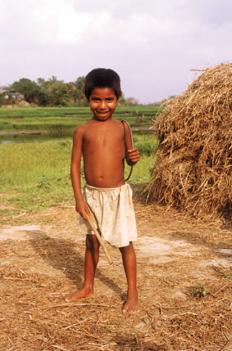
What could be more pleasurable than running wild amongst the village greenery?
Yet another variation of this catch-me-if-you-can game is Borof Pani. Here the chor plays the role of Mr. Freeze. He catches his victims and screams borof (ice) in order to freeze them. It is up to the other players to save the frozen ones by tapping them and shouting out pani. This unfreezes them and they are then free to run around again. However, it is quite tricky to unfreeze someone since Mr. Freeze will carefully guard his frozen victims so he can freeze anyone who tries to come to their rescue.
Ludu has always been the most popular board game among children in Bangladesh, although it is widely played all around the world. The first player to make a trip around the board and make it to "home" wins. The game is often continued to determine second place, and so on.
Carom board is very popular and is a game where one can become highly skilled through practice. The conventional version of the game is played in groups of two, each group going after one chips of one colour. The team that wins the board gets points for each opposition chip remaining on the board, and extra points if they have taken the red piece. The first team to take twenty-nine points wins. There is another unofficial version of Carom played by kids called Taalgaachh. Chips are stacked one on top of the other at the centre of the board. Everybody sinks as many pieces as they can, regardless of colour. In the next round everyone puts back into the board a number of pieces equal to what the person with the least chips has. This is continued till only one player survives. Carom is one of those addictive games that become popular in school or even the workplace.

Pushing a wheel made of wire with a stick is all it takes for little boys to have fun.
Today kids are hooked on computer games at home or watch TV for hours on end, sometimes without even speaking a word to another human being. There are hardly any fields to play in and as for closely knit neighbourhoods, those too are relics of the past. For those of us lucky enough to have grown up at a time when roads were safe enough for children to walk around unchaperoned, when neighbours were like family and a wooden toy train would evoke just as much thrill as a battery operated race car today, the toys and games of our childhood are still very much part of what we would call the best times of our past.
These days, children hardly play any traditional games; they are more into cricket, football and badminton or they do not play any sport whatsoever. Electricity has reached many villages across the country, which has led to the popularity of the television and cassette player. The 'country games' as a young banker terms them, are no longer fun as they are not considered 'trendy' or 'cool'. Thus, they have been replaced in an unfair and undignified manner by leisure activities that are more congruous to the modern times.
Yet it is perhaps na�ve to think that toys like the rag doll or the simple bow and arrow can compete with the ubiquitous Barbie doll and the battery operated laser gun. Nor can we hope to lure the video game buff away from the latest computer game. Children, after all will adopt that which is new and trendy. At the same time we can still let them know about the traditional toys and games that filled our childhood with so much joy. Institutions such as the Shishu Academy and museum can procure and preserve these toys before they completely die out. Games of course, can be revived nation wide say, through competitions in school and colleges which can be televised and shown on different channels. If there's one thing kids appreciate, it is having fun. No matter how traditional it is.